
2007 Trip to Alaska - Andrew and Corey Geving

In July of 2007, we headed north to sample some backwoods fishing in some of the more accessible parts of the great state of Alaska. Two weeks of solid fishing left us completely worn out. This is the story of our trip.
Part 1: Welcome to Alaska - Fishing the Kenai Peninsula Creeks
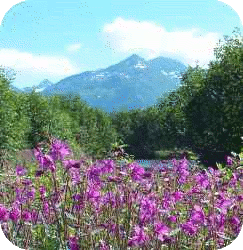
After crashing at our cousin Tyler's in Anchorage after our arrival, we set out to get fishing right away! We had an Alaska Atlas, a copy of "Flyfishing Alaska", and a spunky little compact car loaned to us by our generous cousin, who is a prince among men. We motored on down the trail, looking for fish on all the creeks and rivers of the Kenai Peninsula.

We jumped in the car and drove east down Turnagain Arm of Cook Inlet. We wanted to get outside the reaches of the city quickly, so we blew by crowds of people looking at Mountain Goats along the roadway. Finally, we hit a stream we liked the looks of - Ingram Creek.

The Corolla heaves to a stop at Ingram Creek. Despite a few missing parts (headlight, tail light, door handle, suspension) this car was a great Alaskan vehicle; it valiantly carried us all over the south-central part of the state while barely sipping gas. Tyler loaned us the car, with only one stipulation - we needed to deliver some CD's to his friend Chunk in Cooper Landing. Almost everyone pegged us for native Alaskans when we pulled up in The Corolla, and immediately started quizzing us on how to catch fish on every stream we stopped at. Imagine their surprise when we told them this was our first visit to Alaska! But we gave them good advice anyway, and by the time we left we were handing out flies and helping the folks from Illinois and Texas catch fish. We decided to fish Ingram when we saw it was full of salmon; we spotted a lot of pinks in the stream, and there were a few people there catching them. Already familiar with pink salmon from fishing them in Lake Superior, we broke out the egg patterns. We thought the humpies would be a great warmup for Alaska fishing, and we could get updated lifelist photos for this species in the process.

On my second drift in Ingram Creek, this spunky male Pink Salmon took my glow-bug egg pattern and made for a nice update to my lifelist photo for this species. We'd caught our first fish in Alaska! The bright sun and clear water made finding the fish easy. I found a deep slot next to a big boulder and made another drift.
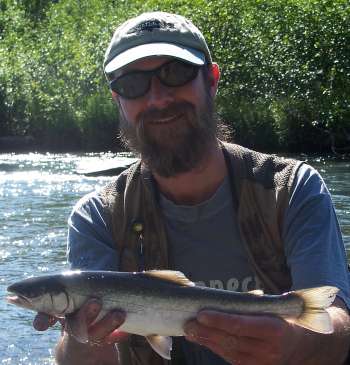
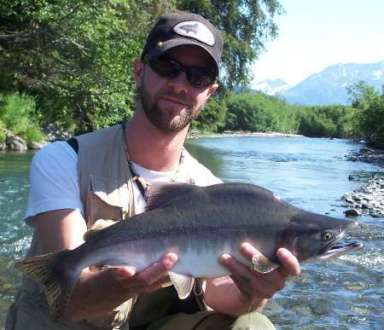 |
 |
Andy quickly joined the fray with a pair of pinks of his own, a hump-backed male and very fresh and silver female.

Ingram Creek was a blast, but we had a lot of fishing to get to! Still, our first stop had produced two species and we were ready for more. The sunny weather had us in a great mood. Little did we know, we wouldn't see the sun again for over a week! We drove around Turnagain Arm and south into the Kenai Peninsula under cloudy, hazy skies. We took the Seward Highway South, where we thought we might find some Sockeyes and Rainbows at Partridge Creek.

Partridge Creek was devoid of Salmon. We caught a ton of little Rainbow Trout and Dolly Varden in this beautiful little blue-water creek, but after hiking a mile or two of it, we decided to move on. We planned on heading for Seward, but I took a wrong turn and so we got lost and ended up at another creek, in the genral vicinity of Kenai Lake. It began to rain.

We had found the salmon. Dolly Vardens and rainbows vould be seen flashing as they snatched salmon eggs from the current behind the active redds. Andy charged out into the rain to go after them. I took one long look at the angry gray sky and decided to put on my brand-new raingear.
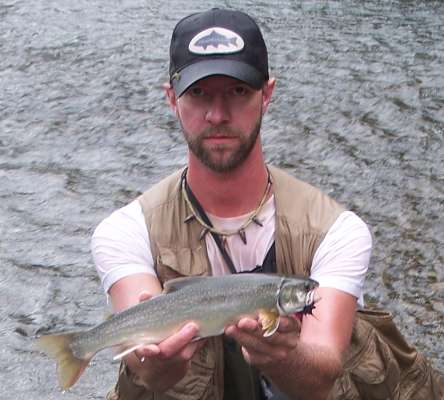
By the time I got to the river, Andy was already battling an acrobatic Dolly Varden.

Then a big sockeye grabbed his fly. I still hadn't made a cast!

The rain turned into a downpour, and a storm moved in. We fished right through it. I finally started catching fish - including this spunky Dolly Varden.

And a huge sockeye for the lifelist! The storm abated and a steady drizzle began. We caught a few more fish, and then packed up and headed west to meet up with the mysterious man known as Chunk.

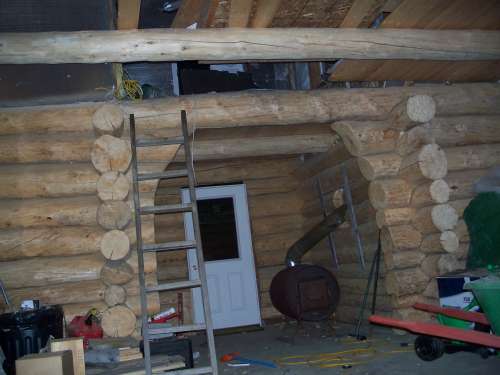
Part 2: Kings in the Boulder Fields - Fishing the Lower Anchor River


We left the cabin in fog and constant misty rain. After exploring a couple of miles of the Ninilchik River, we headed to the Anchor. There were King Salmon everywhere. We started fishing in earnest.

The first fish brought to hand was a new species for the trip. This fairly fresh chum salmon was the first fish of many we landed on the Lower Anchor. This fish slammed an egg-sucking leech, and was the only chum we saw in the Anchor.
Then Andy hooked something bigger. This hen King Salmon was our first King of the trip.
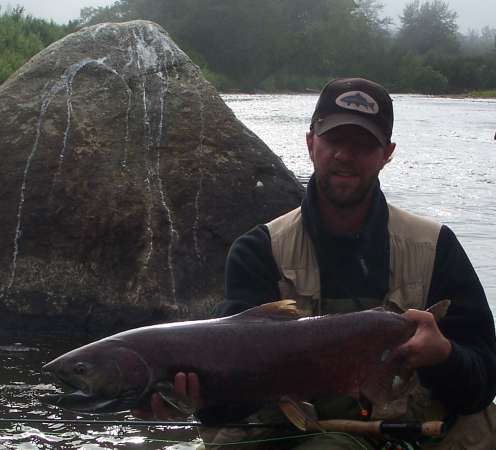
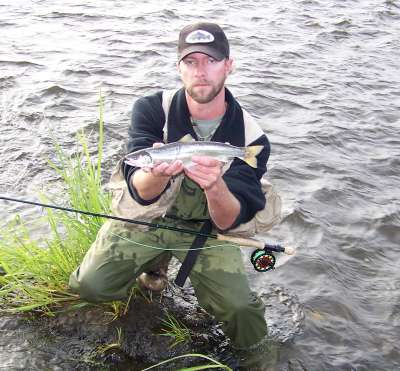
We were getting really hungry. Looking for some smaller fish to cook on the fire, we headed downstream, closer to the ocean. Before long, Andy caught a fresh, silver Dolly Varden - with the crab-like sea lice still attached from the saltwater. We were fishing the first riffle up from the ocean, and there were a lot of dollies around.

A pair of chromer Dolly Vardens got stuffed with Alaskan Fireweed and cooked on the coals for our evening meal. What a delicacy! They were absolutely delicious. From this point on, we had Dolly Varden for dinner almost every night. They're unbeatable as far as eating.

The next morning, I latched onto something big in the boulder fields.

After a massive battle on my 8-weight, I landed my first Chinook Salmon.

The boulder fields on the Lower Anchor proved to be very fruitful. Here, Andy battles another king salmon. But this one was a lot bigger! It took him well into his backing, both upstream and down, before finally succumbing.
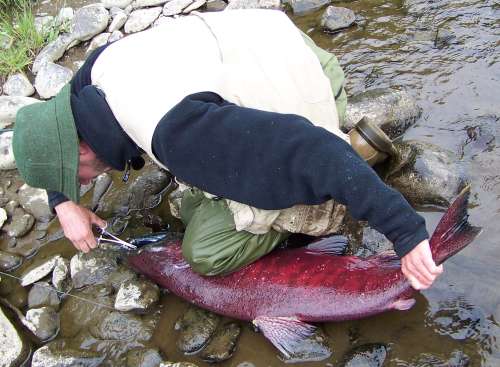
These fish never quit fighting, even after being landed. If they slipped out of your grasp and got back into the water, you had to fight them all over again! Andy took no chances with this brute, getting him unhooked right away.

This beast was our biggest King from the Anchor. It probably weighed between 30 and 40 pounds.

This young moose wandered by while we were fishing.

Since it was opener for the Upper River the next day, we made a quick trip to Homer Spit to fish for silvers in the lagoon. None of them hit our flies, and we were perplexed by the local rigs, which consisted of a huge plastic bobber on the end of the line with a big hook about a foot up from it. Frustrated by the cohos, we bought some bear medicine and headed back to camp for another meal of fresh Dolly Varden.
Part 3: Fishing the Dolly Varden Opener on the Upper Anchor River

On opening day of fishing on the Upper Anchor, we trekked for miles, back into the far reaches of the Upper Anchor wilderness in search of big Dollies. This is a well-known feeding ground for the big coastal brown bears, so we kept a firearm handy at all times.

There are many, many miles on the Upper Anchor, and it all had been closed to fishing until this morning. A few anglers were fishing it, but not many, and everyone was fishing within a mile of the road crossing. Rumor had it that this is where the big ocean-run Dollies could be found. After tasting a few of them, we decided we needed more ... and Andy hooked one, of course, before I even made it to the river.

Andy got this fish on a bead on his first cast. This was shaping up to be an incredible day of fishing.

These fish are tough fighters, much like a steelhead but they jump more. Andy slipped a bead underneath the overhanging brush on the far bank and a big fish pounced on it.

The fish finally gave up, and ended up on a stringer. Every bend of the river was full of fish like this.
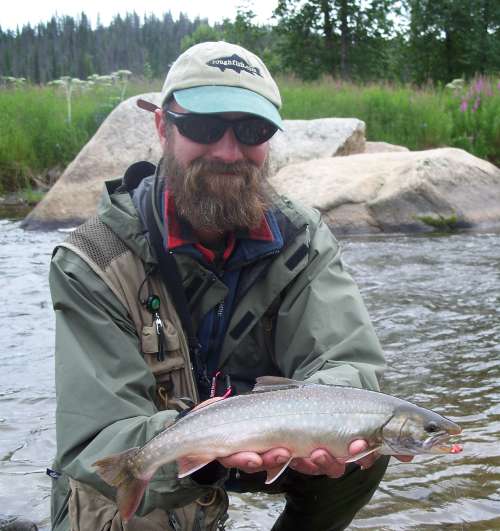
I caught this nice Dolly on my beadhead dayglow woolly worm.

This is a typical Dolly Varden from the Anchor - about 15 inches long.

Some of them were just starting to show their spawning colors.

But this one was still bright chrome from the ocean.

Here's another beautiful Dolly Varden.

Kings were spawning all over the upper Anchor, so we fished egg patterns behind the spawners.

Andy poses with most of our limit of Dollies. We caught around 40 or 50 apiece and kept the choicest ones.

Then, we visited our relatives in Soldotna - thanks for everything David and Judy! We enjoyed a delicious meal of Alaskan-style Kenai River sockeye salmon, and headed back toward Anchorage under the cover of darkness. We had to find a bush pilot in Anchorage, so we wanted to leave plenty of time, but we didn't make it. Moose kept jumping out in front of The Corolla, and fog and rain made driving difficult. I got very tired. We had to pull over, pitch our tent, and sleep. The next day, we woke up early and quickly threw all our gear in the car and headed for the Lake Hood Seaplane base, to hire an air taxi.
Part 4: The Packrafting Adventure Begins - Exploring Judd Lake and Talachulitna Creek
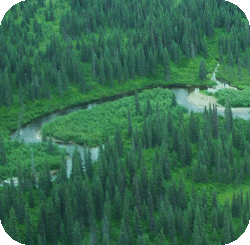
After visiting relatives in Soldotna and enjoying an amazing meal of fresh Kenai-river sockeye, we burned our way back to Anchorage and hired a bush pilot to drop us off way back in the wilderness, to begin our packrafting adventure.

Back in Anchorage at the Hood Lake Seaplane Base, we looked for a pilot. The first couple of pilots wouldn't let us go out there without guides. Then we finally convinced somebody to fly us out there by ourselves, even though they strongly recommended against it. But they couldn't leave for SIX HOURS. We told them we'd be back in six hours, and kept looking. Then we found a guy with a float plane, and he said he would fly us out there, and pick us up on the Skwenta a week later. But he had to leave in 5 minutes! We frantically threw our gear together and piled into the small plane. Without warning, we shot off into the air and watched the wildlands slip by underneath us.

Our pilot took us to the mouth of the Skwentna River, where we buzzed over a huge pod of snow-white Beluga Whales, which were headed up the river to chow on salmon. Then, we passed over 50 miles of treacherous boglands. Finally, we flew over the Taluchulitna on our way to the dropoff point at Judd Lake. It was some wild, thick, untravelled country. There was nothing down there but trees, bogs, moose, and a winding ribbon of water which would hopefully carry us home. Then a lake came into view, and the pilot lurched the plane into a steep diving turn, and before we knew it we were gliding across the choppy gray surface of Judd Lake.

Once we got the plane hauled to the shore, we chucked all of our gear onto the beach. Our pilot helpfully informed us that he was a bear hunting guide, and this beach was his best spot to find a big bear. Big dark clouds were headed in our direction, so our pilot jumped back into his plane and gunned it back into the air before we could even wave goodbye. Soon, he was a rapidly disappearing speck on the horizon. Then he was gone, and it was very quiet.
It's a lot to absorb all at once. This is what makes unguided adventures real, and guided adventures completely fake. There you are, with whatever gear you brought with you. You hope you prepared well, and you hope you're up to the task. But there's nobody there to bail you out. No satelite phone, no emergency help, nothing. If something goes wrong, you can't complain to a guide, you just have to be a man and deal with it. We had no idea what difficulties we would face, but we had the guts to face them anyway.
We had the following: A pair of Alpaca one-man rafts about 4 feet long with paddles, a small two-man tent and sleeping bags, a little bit of emergency food, clothes, waders or hip boots, a packable MSR stove and two bottles of fuel, a first aid kit, fishing tackle, and a .357 magnum revolver with 60 rounds of ammunition. NOTE: Thanks for the emails about the ammo supply. Yes, 60 rounds was a bit excessive. Yes I carried all that weight downriver for nothing. I stand by my decision.

So there we were. No going back now! We had to cover 58 miles of rough, trackless terrain far from civilization in 7 days. Once we got the rafts inflated, we repacked and rigged our gear for travel. That's when I found out that my raincoat was missing. This was grim news. With the constant rain we had faced for the last six days, and no shelter except for a tiny tent, I was in big trouble; I would be constantly fighting hypothermia for the next week with no way to stay dry. But we had to soldier on anyway. I took the yellow raft, and Andy the green one. Our cousin Tyler had loaned us these amazing backcountry inflatables, which he uses for cross-country trekking in the Alaskan wilderness. Although they might LOOK like pool toys, these "Alpaca Rafts" are the best packable waterborne transport that money can buy, built to withstand all the punishment you can dish out and keep you alive.

Our first task was to make it across the clear, cold, windy lake. We made it easily, and entered the creek. It became obvious right away that, contrary to our expectations, the creek was far too low to float. We had hoped for low water, since that meant nobody could take guided trips down the river in their big cata-rafts. This meant we had the river to ourselves. But the water was too low for even our packrafts. With no way forward, we would have to proceed on foot. We re-rigged the rafts for pulling through extremely shallow water.


Andy caught a fresh sockeye. We probably should've eaten it. These sockeyes were very fresh and hadn't turned red yet.

And a beautiful Dolly Varden for dinner. We packed the bare minimum as far as food, only a few bags of noodles, some venison jerky made by my dad for energy during the day, and some dehydrated apple rings. We had to eat a lot of fish as we made our way down the river, or we would go hungry. Catching dinner was always a priority! But travel was very tough, we would make it a few hundred yards before bottoming out in a riffle and having to get out of our rafts and walk. After the first twelve hours of travel, we had only made it about two miles.

Andy spotted an aggressive Chum Salmon in a current break and got him to take a big pink fly. Alaskan salmon cannot resist a big, pink, goofy-looking fly. Of course, Andy and I, being Great-Lakes Steelheaders, had armed ourselves with all kinds of crafty subtle lures that can be used on pressured fish. But if you want to catch fish in the remote areas of Alaska, you might as well chuck some crazy gigantic fluffy fluorescent sparkly thing with big buggy eyes. Trust me, it works.
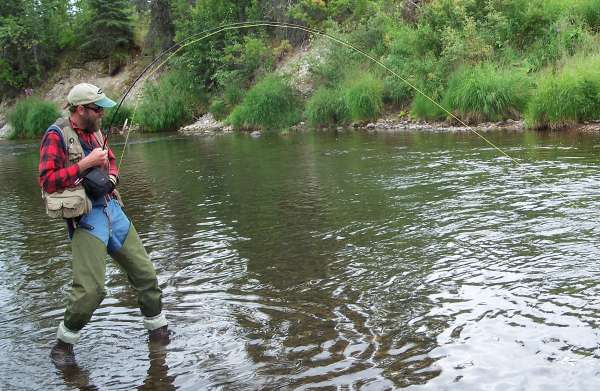
A king swam up and crushed my fluorescent pink bunny leech, and I layed the beef to him. With a limited supply of flies, you really didn't want to break off, but if you didn't fight these fish tough from the get-go, they would walk all over you.

I won the battle, this time. I was casting my fly at a big, ugly-looking chum and all of a sudden this huge king charged up from twenty feet away to engulf my fly.
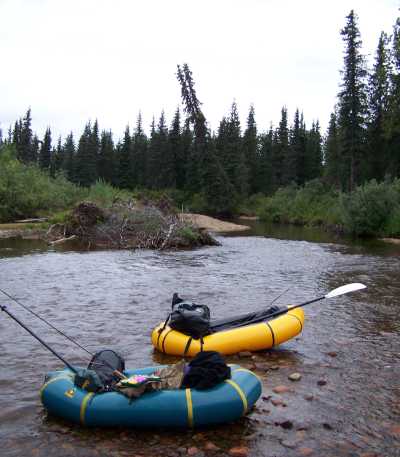
Here is our gear. This is everything we had. Two tiny rafts, fishing poles, a couple of dry bags, and our paddles.

All of the guidebooks said that "you must never make camp where there is any bear sign." Well, every square yard of ground within 100 feet of the river was plastered with bear tracks, and every sandbar had a dozen huge piles of grizzly bear crap on it. We had to make camp right on top of bear sign. In fact, we actually had to clear away the piles of bear crap in order to make camp.

We hiked and dragged all day, but fished a lot, and only made it a couple of miles to the mouth of Chicken Creek, where we made camp. We had a long way to go, and it looked like rain. Andy set up our tent, and started laughing - my raincoat was balled up in the corner of the tent. I was extremely happy.
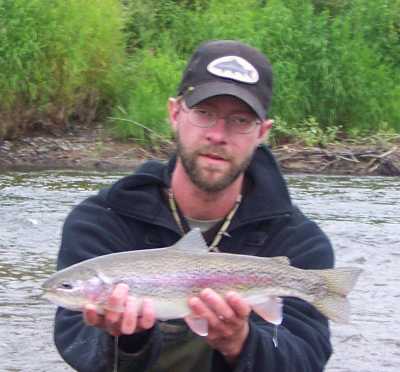
The next day, Andy got our first Taluchulitna rainbow on an egg imitation.

Another nice sockeye.

And finally, a beautiful chum for my lifelist!
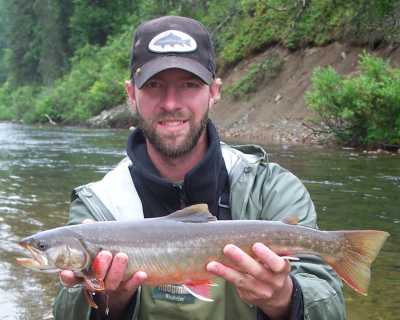
Andy caught a big, beautiful Dolly Varden for dinner.
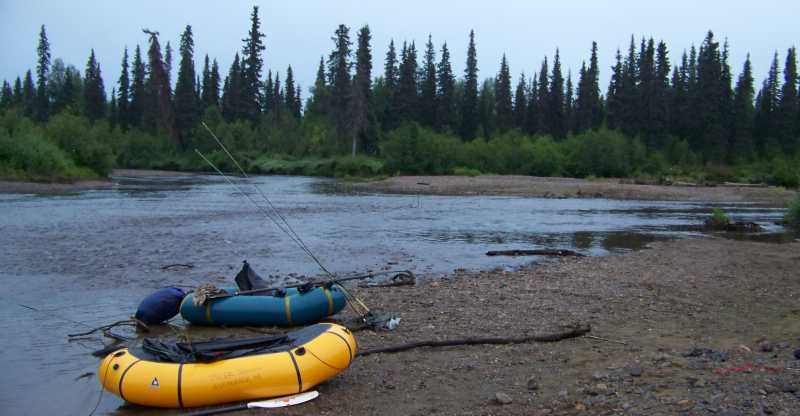
Part 5: Below the Forks - Floating the Upper Talachulitna

This section of the Tal was a mix of fast and slow water. It was deeper, allowing for more floating, and had a great mix of species.

We had finally reached The Forks! The river got bigger here. It was also a good fishing hole, so we were reluctant to leave.

While the river was bigger, it was faster and more powerful, meaning it had enough erosive power to knock down trees. The river was choked with dangerous logjams and fallen trees. Some of them could be navigated, but most could not, so we ended up spending a lot of time hauling all our gear around obstacles in the river. Luckily, we were travelling light. Our packrafts and gear could be carried around a quarter-mile long logjam in fifteen minutes, while a fully outfitted group in a cataraft could take several hours to do the same.

There were plenty of rainbows to be had in between the logjams.

Some of the rainbows were of a respectable-size.
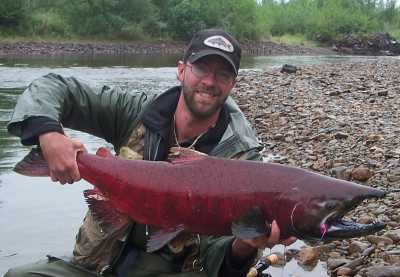
The Kings were always present, in every pool, and every so often one would attack. When a king wanted your fly, there was no way to keep them off your line.

Another rainy camp. It had been 8 days since we had seen the sun.

A bit of target practice to scare away any bears in the immediate area.
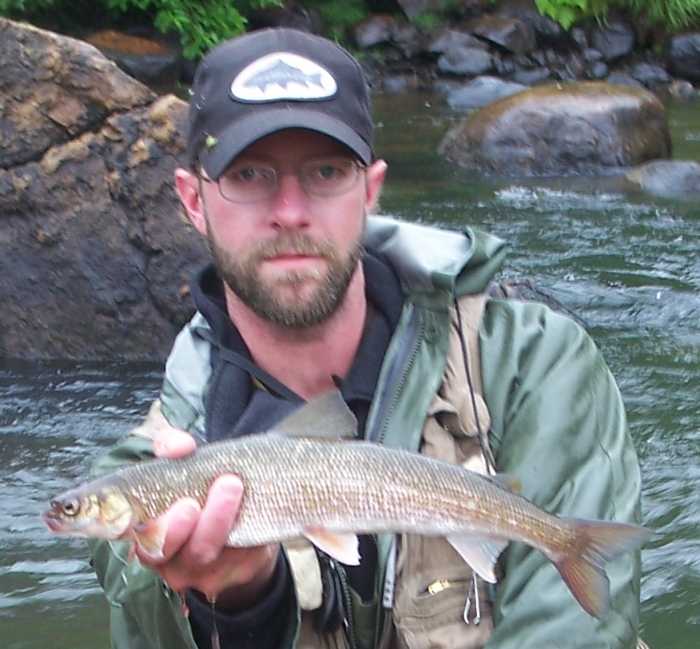
A round whitefish for Andy! I had a theory that there were some to be found in this river, but never in my wildest dreams did I expect us to catch one. Here, Andy racks up a lifelist species, and confirms the presence of this species in this river.
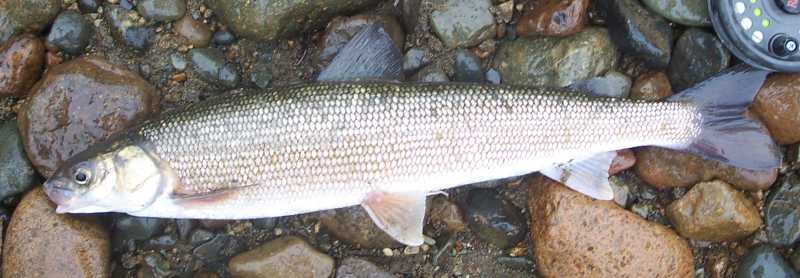
Round whitefish. We ate it with noodles, for dinner.

Then, I broke both my flyrods in a raging rapids. We took a break and a shot of whiskey, and got back on the river.
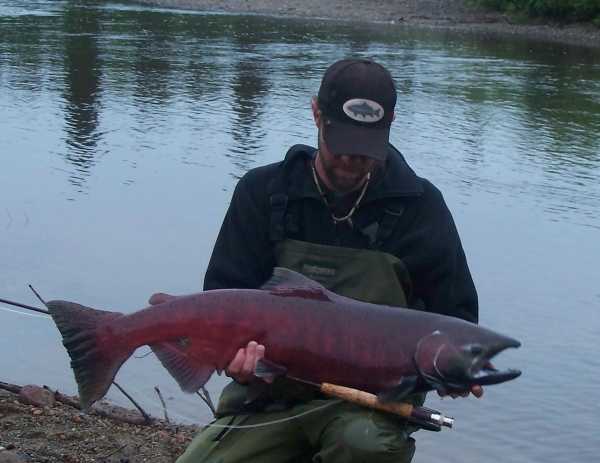
Andy hooked and landed a 30+ pound king salmon on his 5-weight flyrod.

More floating. It was getting easier now.

Then the sun finally came out! We couldn't believe it! We had forgotten what it looked like.

Beautiful weather moved in. But the river flattened out, and we had to paddle a lot - against a fierce subarctic wind that howled for the next few days.

We were finally able to dry out all our gear. The combination of sunshine and wind meant everything got dried out in no time at all. Our tent kept getting knocked over by the wind.

We made good time through the central section, although there was one long section with no current that we had to paddle through. We could finally see the scenery around the river - up until now we could barely see past the banks through the fog and mist.

Last camp before the canyons.

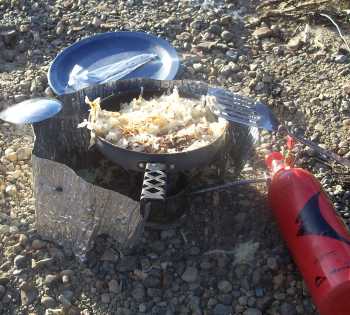
Dolly Varden and Hashed Browns for dinner! We would need the energy, because we were about to enter the Canyons!
Part 6: Beyond Hell's Gate - in the Canyons of the Talachulitna
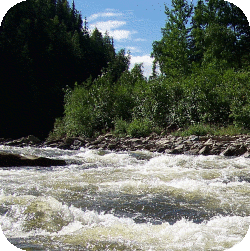
The next, and last, stage of our journey brought us into a wild and woolly area called The Canyons. Filled with rapids, flanked by towering cliffs, and filled with fish, this is the best of the best.

Finally, we reached Hell's Gate - the entrance to the Taluchulitna Canyons.

Hell's Gate was clogged with debris. We probably could've run it, but the log on the left had a bunch of sharp points on it that could puncture our borrowed rafts. We portaged around it.
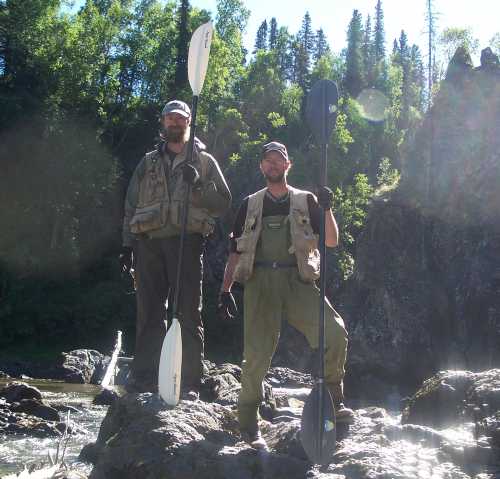
At the bottom of Hell's Gate.

The water picked up speed and raced through fields of boulders.

In no time at all we reached the mouth of Friday Creek.

We started catching Arctic Grayling. We had caught a few small ones on the upper river, but these were sizable.

Andy with a Grayling.

Andy with a nice Pink Salmon. There were a lot more pinks in the lower river - not many made it past Hell's Gate.

We ran upper flipper rapids. This is a series of 4-5 foot drops split by multiple large midstream boulders. We had been making such good time that we came upon this rapids unexpectedly and got sucked in. I got pinned on a boulder for a few tense seconds, but managed to spin myself off the rock and went down the final drop backwards. Andy came through with flying colors.

While we were plotting our next move, Andy spotted movement on the far shore. Sure enough, some kind of brownish animal was running up the bank toward us. It was a grizzly bear cub. We never saw the mother bear, but she was very close by.

I snapped a few photos of Andy as he hurtled down Lower Flipper Rapids. The two series of rapids are only about 100 feet apart. The upper set is the more difficult of the two, and it sneaks up on you.

A mile or so past Flipper, Andy suddenly yelled for a halt in a swift, necked-down chute. I barely managed to wedge my foot onto a boulder before getting swept downstream. But Andy's instinct was dead-on - this was a rainbow trout honey hole.

Rainbow trout have been stocked and transplanted all over the world, but catching them here, in their native habitat, was a real treat. These aren't your grandpa's trout pond rainbows. These "Leopard Rainbows" fight like rabid devils and are as fast as lightning.

Our biggest rainbow was this 23 incher.

After getting badly beaten by a 25+ incher, I regained some of my pride with this 20.

The Canyon was amazing. Towering cliffs loomed on every side as the river twisted and snaked its way through glassy pools and lively rapids. We sighted a lot of ridiculously large kings in this stretch, but the pink salmon dominated the lower river. Rainbows were everywhere, and Andy even saw a school of longnose suckers in one pool. Finally, in the last mile or so, we encountered a few people.
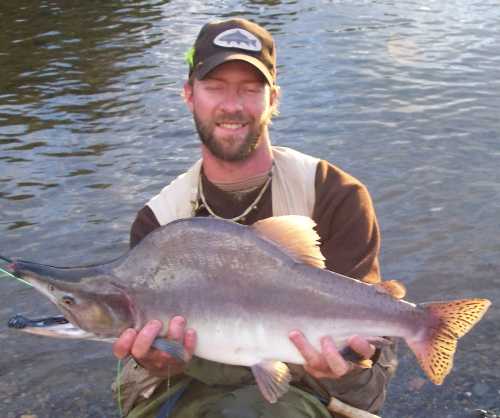
Pink Salmon.

We stopped in at Talaview Lodge, where Tyler's friend Pat works. He treated us to a steak dinner! Talaview was a beautiful place, with black bears around every corner. One walked up to the window and looked in while we were having dinner! Thanks Pat and friends for the hospitality!
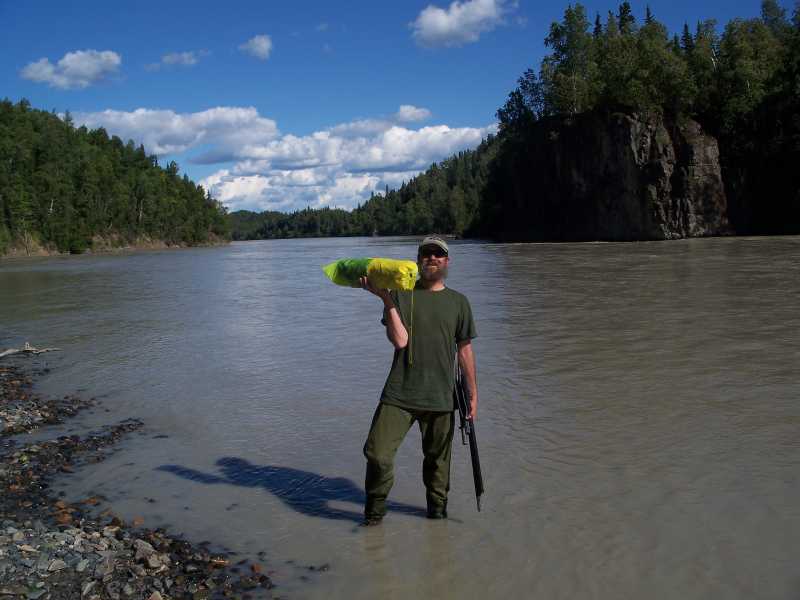
We camped near the mouth the last night, and then paddled out past dozens of guided fishermen in jet boats to get to the Skwentna. The trip to the takout point was a harrowing battle on this huge, glacial river, made worse by the fact that our pilot had given us bad directions to the pickup spot. But we finally made it, and rolled up the rafts and put them back in their bags. Before long, our journey was over, as our float plane came rocketing down the river. It was tough leaving that beautiful place behind.
Species List:
- Dolly Varden
- Grayling, Arctic
- Salmon, Chinook
- Salmon, Chum
- Salmon, Pink
- Salmon, Sockeye
- Trout, Rainbow
- Whitefish, Round
 Powered
Powered
Comments
Deftik
Fri, 12/07/2012 - 12:18
Permalink
Best thing about this site?
Best thing about this site? Old expedition reports youve never saw before. Awesome job guys, even if it was almost 6 years ago!
andy
Fri, 12/07/2012 - 22:44
Permalink
going back soon...
johnny
Mon, 12/31/2012 - 10:02
Permalink
Holy crap
This is something I need to do. And soon. This is the best report I have ever read. I am green with envy!
Just your run of the mill Orvis Boy. Fly fishing elitist. I cannot hear you over my false casting. All guided trips every day.
Fishing for compliments since 88.
JediMasterSalmo...
Fri, 01/03/2014 - 17:41
Permalink
Alaska Rocks!
Great write up and photos. I can live here my entire life and not experience everything Alaska offers. Thanks for sharing your experience. If you ever return and you want to do some trophy grayling fishing, I know a good spot.
www.alaskansalmonslayers.com
andy
Fri, 01/03/2014 - 23:19
Permalink
Thanks for the invite!
My brother and I will be back to Alaska sooner than later. Ican't believe it has been this long really.Will look you up for sure!
andy
Tue, 02/10/2015 - 16:52
Permalink
Cousin Tyler on Ultimate Survivor Alaska
Our awesome Cousin Tyler from this story has been on the National Geographic program Ultimate Survival Alaska for three seasons now. He is currently on the "Alaskans" team for season three. Thought I would mention this in case some of you watch the show, he is kind of a bad ass.
Mike B
Tue, 02/10/2015 - 19:53
Permalink
Well that's cool and I do wat
Well that's cool and I do watch that ashow time to time. I will watch it more now.
mike b